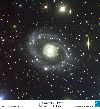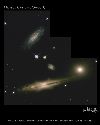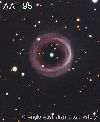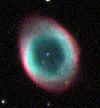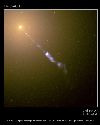WHAT IS A GALAXY?
SPIRAL GALAXIES
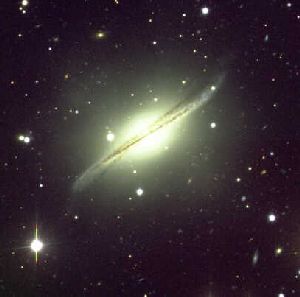 Spiral galaxies are colossal disks of mostly hydrogen gas, dust and stars. They have three main components: a flattish disk, a central bulge, and a surrounding halo. The disk contains gas, dust, and billions of young stars in spiral arms. The bulge in the center of the disk contains mostly old stars and no gas or dust. The halo is the home of a very few, scattered stars and globular clusters.
Spiral galaxies are colossal disks of mostly hydrogen gas, dust and stars. They have three main components: a flattish disk, a central bulge, and a surrounding halo. The disk contains gas, dust, and billions of young stars in spiral arms. The bulge in the center of the disk contains mostly old stars and no gas or dust. The halo is the home of a very few, scattered stars and globular clusters.
The picture on the right is an edge-on view of a warped spiral galaxy showing the flat (but warped) disc, the dust lane and the central bulge. The stars and globular clusters of the halo are lost in the glare of the central bulge. The diameter of this galaxy is 600 thousand million million miles. All the stars scattered through the picture are foreground stars in our own Milky Way Galaxy.
(Picture Credit: Galaxy ESO 510-13, FORS Team, 8.2 metre VLT Antu, ESO)
ELLIPTICAL GALAXIES
Elliptical galaxies can be circular or egg-shaped, formed from many billions of stars orbiting the center of the galaxy just as the Sun is orbiting the center of our galaxy. All the light of the galaxy comes from the stars. Elliptical galaxies are old, they formed all their stars a long time ago and are no longer making new stars.
THE MILKY WAY GALAXY
The Milky Way galaxy is the spiral galaxy we live in, along with roughly 100 billion other stars. It looks very much like other spiral galaxies when viewed from above. There are spiral arms and a bright central part. Our Sun and solar system are about halfway out from the center of the Galaxy on a spiral arm. The Sun is revolving around the center of the Galaxy at a speed of half a million miles per hour, yet it will still take 200 million years for it to go around once.
Like other spiral galaxies, the Milky Way Galaxy has a bulge, a disk, and a halo. Our Sun is itself a fairly young star at only 5 billion years old. The Milky Way galaxy
is at least 5 billion years older than that.
GLOBULAR CLUSTERS
There is no gas or dust in a globular cluster and the stars are old. In fact, globular clusters may be the some of the oldest objects in the universe.
Globular clusters contain hundreds of thousands or millions of stars but not as many as an elliptical galaxy which can contain hundreds of billions of stars! And while elliptical galaxies are sometimes round, globular clusters are never elliptical.
Globular clusters are found both in spiral galaxies and in elliptical galaxies. The Milky Way, for example, has over one hundred globular clusters throughout it's halo.
Home
 Spiral galaxies are colossal disks of mostly hydrogen gas, dust and stars. They have three main components: a flattish disk, a central bulge, and a surrounding halo. The disk contains gas, dust, and billions of young stars in spiral arms. The bulge in the center of the disk contains mostly old stars and no gas or dust. The halo is the home of a very few, scattered stars and globular clusters.
Spiral galaxies are colossal disks of mostly hydrogen gas, dust and stars. They have three main components: a flattish disk, a central bulge, and a surrounding halo. The disk contains gas, dust, and billions of young stars in spiral arms. The bulge in the center of the disk contains mostly old stars and no gas or dust. The halo is the home of a very few, scattered stars and globular clusters.







